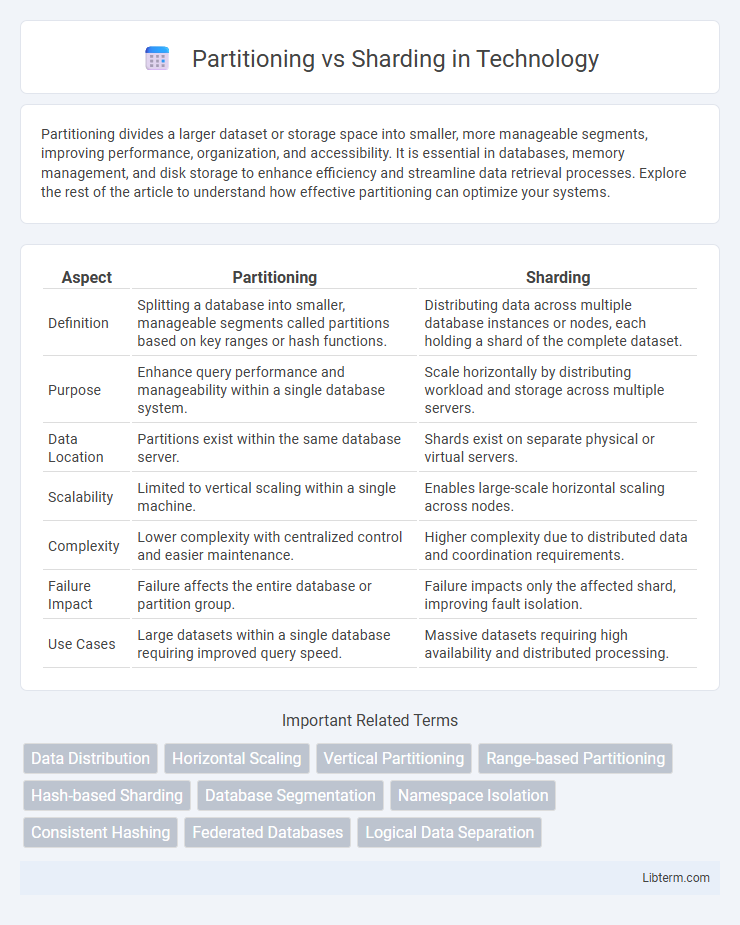Partitioning divides a larger dataset or storage space into smaller, more manageable segments, improving performance, organization, and accessibility. It is essential in databases, memory management, and disk storage to enhance efficiency and streamline data retrieval processes. Explore the rest of the article to understand how effective partitioning can optimize your systems.
Table of Comparison
| Aspect | Partitioning | Sharding |
|---|---|---|
| Definition | Splitting a database into smaller, manageable segments called partitions based on key ranges or hash functions. | Distributing data across multiple database instances or nodes, each holding a shard of the complete dataset. |
| Purpose | Enhance query performance and manageability within a single database system. | Scale horizontally by distributing workload and storage across multiple servers. |
| Data Location | Partitions exist within the same database server. | Shards exist on separate physical or virtual servers. |
| Scalability | Limited to vertical scaling within a single machine. | Enables large-scale horizontal scaling across nodes. |
| Complexity | Lower complexity with centralized control and easier maintenance. | Higher complexity due to distributed data and coordination requirements. |
| Failure Impact | Failure affects the entire database or partition group. | Failure impacts only the affected shard, improving fault isolation. |
| Use Cases | Large datasets within a single database requiring improved query speed. | Massive datasets requiring high availability and distributed processing. |
Introduction to Data Distribution Strategies
Partitioning divides a large database into smaller, manageable segments based on specific keys, improving query performance and maintenance by localizing data access. Sharding extends partitioning by distributing these segments across multiple servers or nodes, enabling horizontal scaling and high availability. Both strategies optimize data distribution, but sharding is designed for large-scale, distributed systems requiring load balancing and fault tolerance.
Defining Partitioning and Sharding
Partitioning refers to dividing a database or table into smaller, manageable segments called partitions, each stored and accessed independently to improve performance and manageability. Sharding is a specific type of partitioning where data is horizontally split across multiple distinct database instances or servers, enabling distributed storage and scalability. While partitioning primarily targets organizational efficiency within a single database, sharding emphasizes load distribution and high availability across multiple nodes.
Key Differences Between Partitioning and Sharding
Partitioning divides a database into distinct segments called partitions based on a specific key, improving manageability and query performance within a single database system. Sharding distributes data across multiple servers or nodes, enabling horizontal scaling and higher availability for large datasets by treating each shard as an independent database. Key differences include that partitioning operates within one database instance, whereas sharding involves multiple distributed database instances, and partitioning often targets performance optimization, while sharding focuses on scalability and fault tolerance.
Types of Partitioning Techniques
Partitioning techniques include horizontal partitioning, which divides a database table into rows across multiple tables, and vertical partitioning, separating columns into different tables to optimize query performance. Range partitioning distributes data based on specific key ranges, while list partitioning allocates rows to partitions based on predefined discrete values. Hash partitioning assigns rows to partitions using a hash function on a key, ensuring even data distribution and load balancing.
Common Sharding Architectures
Common sharding architectures include horizontal sharding, vertical sharding, and directory-based sharding, each enabling databases to split data across multiple servers for improved scalability and performance. Horizontal sharding, or range-based sharding, partitions data by rows, distributing key ranges across shards to balance load, while vertical sharding divides tables by columns to separate different data types or features. Directory-based sharding employs a lookup service to map data to specific shards, enhancing flexibility but requiring additional maintenance.
Benefits of Data Partitioning
Data partitioning improves database performance by distributing large datasets into smaller, manageable segments, reducing query response times and enhancing scalability. It enables parallel processing, which allows simultaneous access to different partitions, increasing throughput and fault isolation in case of failures. Effective partitioning also simplifies maintenance tasks such as backups and archiving, minimizing system downtime and resource consumption.
Advantages of Database Sharding
Database sharding offers significant advantages by distributing data across multiple servers, which enhances scalability and improves overall system performance. It allows horizontal scaling, enabling handling of large volumes of data and high-throughput workloads more efficiently than traditional partitioning. Sharding also improves fault tolerance by isolating failures to specific shards, minimizing the impact on the entire database system.
Challenges in Partitioning and Sharding
Partitioning faces challenges such as uneven data distribution leading to hotspots, complex query routing, and difficulties in maintaining data consistency across partitions. Sharding introduces additional complexity with cross-shard transactions, increased operational overhead for shard management, and potential performance bottlenecks if shards become imbalanced. Both approaches require robust strategies for data rebalancing, fault tolerance, and ensuring seamless scalability to handle growing datasets effectively.
Use Cases: When to Partition vs When to Shard
Partitioning is ideal for improving query performance and manageability within a single database by dividing large tables into smaller, more manageable segments based on key ranges or lists. Sharding is best suited for scaling out databases horizontally across multiple servers to handle massive datasets and high-traffic workloads by distributing data based on a shard key. Use partitioning when working with moderate data sizes and aiming for maintenance ease, while sharding is necessary for systems requiring high availability, fault tolerance, and linear scalability across distributed environments.
Best Practices for Implementing Partitioning and Sharding
Best practices for implementing partitioning include selecting an appropriate partition key that evenly distributes data to avoid hotspots, regularly monitoring partition performance, and ensuring data locality to optimize query efficiency. When implementing sharding, it is crucial to design a shard key with balanced write and read loads, maintain consistent hashing or range-based sharding to prevent data skew, and implement robust mechanisms for shard rebalancing and failover handling. Both approaches benefit from thorough capacity planning, automated scaling strategies, and comprehensive backup and recovery processes to maintain system reliability and performance.
Partitioning Infographic

 libterm.com
libterm.com